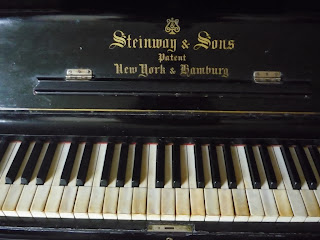Stories in the Key of Life
Inspiration often visits me in one of two places: in dreams or in the tub. Is it being in the prone position, the regression to the womb, full of primal wants and fears, that touches chords deep within me? I was in the tub reading an old National Geographic when the initial inspiration for The Tide King came to me (then, a short story about the recovery of the WWII warship The Bismark). And, I was in the tub reading an old New Yorker when the idea for "The Piano" came to me. (Maybe it's just the reading of old magazines.)
I tend to write a lot about music (symphonic, mostly) and theater, I've discovered, in my stories. I have an aptitude for neither, so I suppose it's my way of living vicariously in them, mediums I love. I am also fascinated with the complex, arrangements of theater acts and symphonic arrangements, how they mirror human relationships.
"The Piano" grew not only from that fateful session with the The New Yorker but also my obsessive searching on Craigslist for a serviceable, free piano. But what would I do with such a monster, with is prohibitive upkeep and demands for space and temperate environment, and how would I communicate with it, speak my words, someone who cannot even play chopsticks?
But sometimes you don't really need the piano at all. Sometimes you just need to write about one.
I tend to write a lot about music (symphonic, mostly) and theater, I've discovered, in my stories. I have an aptitude for neither, so I suppose it's my way of living vicariously in them, mediums I love. I am also fascinated with the complex, arrangements of theater acts and symphonic arrangements, how they mirror human relationships.
"The Piano" grew not only from that fateful session with the The New Yorker but also my obsessive searching on Craigslist for a serviceable, free piano. But what would I do with such a monster, with is prohibitive upkeep and demands for space and temperate environment, and how would I communicate with it, speak my words, someone who cannot even play chopsticks?
But sometimes you don't really need the piano at all. Sometimes you just need to write about one.
On her lunch break, X. bought the upright 1881 Steinway for two thousand dollars from a second-hand store a few blocks over from Washington University. She had been intending to inspect a 19th-century English mahogany Chippendale ribbon back settee she had seen in the storefront on her way to the parking garage, a perfect addition, she felt, to her front hallway. All morning, during her pediatric rounds, she felt the weight and angles of the settee graze the inside of her skull, presenting a fine argument of classic ornamentation much needed in her recently purchased townhouse, still shiny with Windex and Pine Sol and soft, velvety moving boxes that sharply divided her life from Y’s. But when she walked through the dark, musty store, her hospital clogs sinking into the nuzzled warmness of the old, Oriental rug lining the path from door to register, she came upon it, the Steinway, pressed between the stairwell leading to the second floor and a mauve French Empire sofa whose cushions were littered with sheet music.To read more, go here.
How Y. would have loved this, she thought, quite unexpectedly, for she had given up all thoughts of what Y. had wanted months ago, although more out of necessity than desire.

